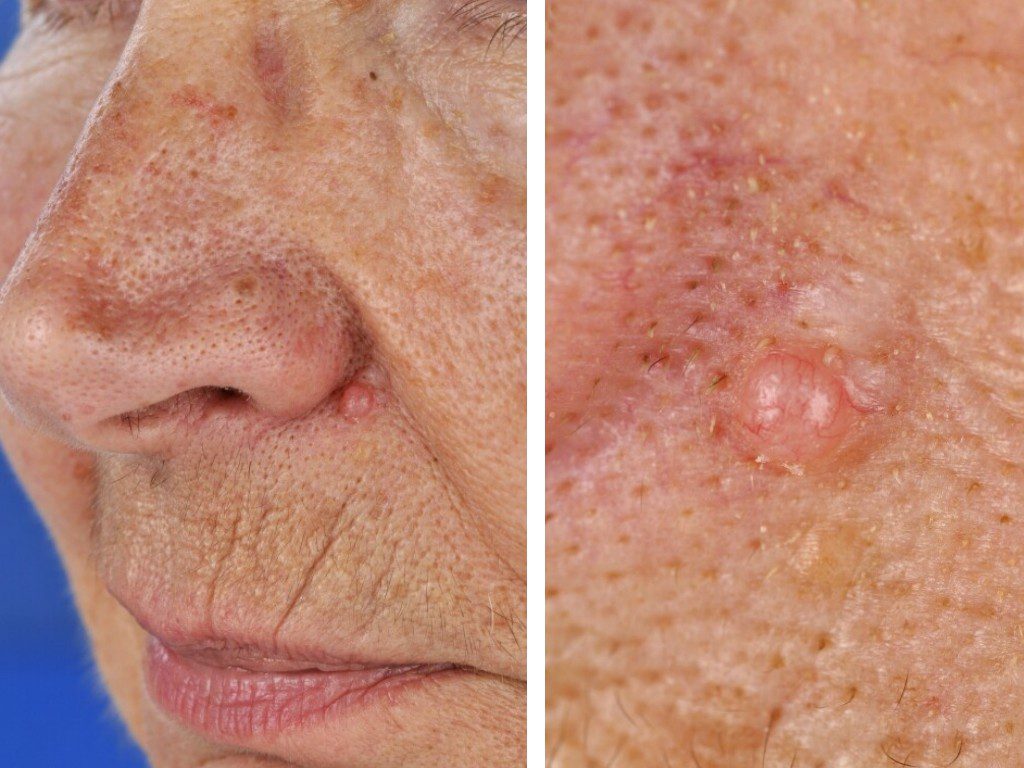Skin cancer
Skin cancer is the most common in the Netherlands compared to other forms of cancer. There are different forms skin cancer. Basal cell carcinoma (BCC) is the most commonly seen, followed by squamous cell carcinoma and melanoma.
During life, about 1 in six Dutch people develop one or more BCC. It arises in the top layer of the skin. The main cause is sun exposure. This concerns both accumulated sun exposure during life, but also sun burns, especially in the youth. This results in irreparable damage to the skin , which can cause skin cancer to develop. In the vast majority of cases, the skin cancer can be treated well with skin cancer surgery. Mohs surgery is used for complex BCC on the face.
BCC on the face
BCC on the face can appear in different ways. For example, it can be a bump that shines and slowly grows larger, as in “nodular” basal cell carcinoma. But it may also be that distinction from normal skin is difficult to see and that the structure of the skin has changed, such as in the “infiltrating” basal cell carcinoma. Basal cell carcinoma usually does not cause any complaints. There may be symptoms that could indicate a basal cell carcinoma, such as a wound that does not heal or an easily bleeding spot. If this is the case, it is wise to see a doctor or dermatologist.
Skin cancer surgery
BCC on the face is excised in most cases. Some of the basal cell carcinomas can be treated with normal excision, which means that the site is excised with a margin of healthy skin around and the wound is sutured. The tissue that has been removed will be sent for examination and you will usually receive the results after 2 weeks.
Mohs surgery is used for difficult basal cell carcinomas. This concerns basal cell carcinoma in the face that is in an awkward place where you do not want to remove too much healthy tissue or that cannot be easily closed but where a skin graft or so-called skin plastic is required. Mohs surgery is only performed when indicated.
Indications Mohs surgery
It is used when it occurs on the nose and around the eyes and ears (called the H zone). In addition, larger basal cell caricnomas can also be treated with Mohs surgery, often with a more aggressive / spiky growth habit. A recurrence (a basal cell carcinoma that has already been removed before but has come back in the same place) and basal cell carcinoma that has not been completely removed during a previous excision are also eligible for Mohs surgery.
Mohs surgery in the Roosevelt kliniek
During Mohs surgery, the visible skin lesion is cut away in a special way under local anesthesia. The wound is not stitched, but bandaged. The patient is taken to the waiting area. The tissue that has been excised is frozen and then slices are cut from it which can be viewed under the microscope. If skin cancer is still seen in the cut edges, then extra tissue will be cut away, only where it is needed. This repeats until everything has been removed. When the cutting edges are clean, the wound is closed. More information on how the Mohs treatment works and find a patient leaflet on this page.
Mohs surgery is performed at the Roosevelt clinic by experienced medical specialists who specialize in skin cancer and skin cancer surgery. A number of them also work at the LUMC’s skin cancer center. In the Roosevelt kliniek, you get best treatment, without requiring you to go to the hospital for this.
